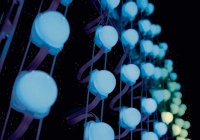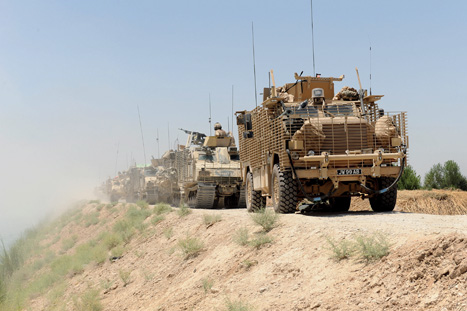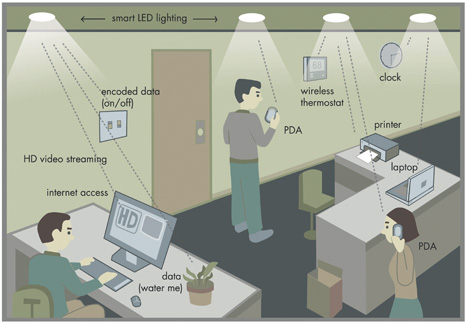
The human desire for light was one of the reasons that caveman became engineer. From the very first camp fires to the oil-filled lamp and electric torch, man-made light has led the development of the modern world.
The objective has always been a simple one: to provide illumination in areas that the Sun can’t reach. We’ve been extremely successful in this, with more and more places on Earth touched by artificial light each day. The technology has showcased our best innovations and given us the ability to see things that would otherwise be hidden.
But what if light could do more than just illuminate? What if it could also send streams of data? Traffic lights, television sets, car headlights, billboards and lamps might all suddenly become far more important in our daily lives. We could receive maps from a street light, get news alerts from lamps and download music from electronic posters.

It may sound like a futuristic concept, but a small community of researchers is already working on ways to make this a reality. They believe that an emerging area of technology known as Visible Light Communications (VLC), which uses the rapid flickering of advanced light-emitting diodes (LEDs) to encode data, could open up new and exciting possibilities in the way we send and receive information.
The work has been pioneered in Japan by the Visible Light Communications Consortium (VLCC). On the back of its research, the US has invested $18.5m (£11.5m) in the development of VLC and the Chinese government is also thought to have put aside large sums to integrate it into aircraft. In Europe, Oxford and Edinburgh universities are involved in research, along with firms such as France Telecom and Siemens.
What has really excited researchers are the advantages of VLC over other forms of wireless communication. VLC doesn’t interfere with radio-frequency (RF) electronics, making it suitable for use in hospitals and aircraft, and it has no associated health concerns. It’s also environmentally friendly, with its use of existing infrastructure reducing costs and allowing for the future expansion of the network.
Prof Zabih Ghassemlooy, associate dean for research at Northumbria University, believes that safety is a major driver. ’We’re now seeing people develop allergies to radiation from radio waves. Perhaps because of this, society will be reluctant to use them - light under moderate power is the way forward. Nature has provided us with this for billions of years and we should be making the most of it.’

The main catalyst behind VLC has been improvements in the performance of LEDs - which are durable, efficient and bright, and are fast replacing incandescent lamps. Unlike normal light bulbs, LEDs respond quickly to ’on’ and ’off’ signals. By flickering an LED light on and off in a specific pattern, data can be sent at speeds that are undetectable to the human eye.
The most basic form of white LEDs are made up of a bluish to ultraviolet LED surrounded by a yellow phosphor, which emits white light when stimulated. On average, these LEDs can achieve data rates of up to 40Mb/sec. Newer forms of LEDs, known as RGBs (red, green and blue), have three separate LEDs that, when lit at the same time, emit a light that is perceived to be white. As these involve no delay in stimulating a phosphor, data rates in RGBs can reach up to 100Mb/sec.
But it doesn’t stop there. Resonant-cavity LEDs (RCLEDs), which are similar to RGB LEDs and are fitted with reflectors for spectral clarity, can now work at even higher frequencies. Last year, Siemens and Berlin’s Heinrich Hertz Institute achieved a data-transfer rate of 500Mb/sec with a white LED, beating their earlier record of 200Mb/sec. As LED technology improves with each year, VLC is coming closer to reality and engineers are now turning their attention to its potential applications.
’In my view, there are two basic areas of application for VLC,’ said Dr Dominic O’Brien from Oxford University. ’There is what you might call the “augmenting existing infrastructure” applications - using the solid-state lighting already present and adding a functionality - and applications where doing it in the visible region has an advantage in terms of security and performance.’
“Edison researched incandescent lamps and it changedtheworld – VLC will do the same”
One of the most promising applications is in car-to-car communication. If the headlights on a car could communicate with the tail lights of the car ahead, VLC collision-avoidance technology would be hugely significant in the automotive industry. In the same way, traffic lights could send detailed information of congestion up ahead directly to a vehicle. But, to be successful, VLC has to prove itself against competing technologies of lidar, radar and RF, as well as to overcome some of its own technical challenges.
’The problem with using VLC outdoors is dealing with atmospheric conditions,’ explained Ghassemlooy. ’Fog, smoke and temperature variation are major difficulties. We’re looking at efficient modulation and coding schemes to see how we can push the beam through the fog without increasing power to the light source… I think we’re getting closer to getting a solution every day.’
As well as problems with weather, VLC needs line-of-sight access to send data, restricting areas where it can operate. But O’Brien points out that its directional approach can also prove to be an asset. VLC is far more secure than RF signals, which move in many directions and can easily be intercepted. In military operations where RF-based communications are restricted during troop movements, VLC could be a viable alternative. For instance, it could be used to help securely pass information down a convoy of tanks and other military vehicles.

But it’s not just on the road that the technology holds promise. The directional nature of VLC makes it ideal for use in underwater communication systems. For instance, Canadian robotics research firm Penguin Automated Systems has developed a system made up of a spherical dome covered in LEDs, each switching on and off 40 million times a second. ’We’ve created a high-speed network that will control swarms of robots for large-scale subsea mining applications,’ said chairman Dr Greg Baiden. ’But it’s not just for underwater. If we want to do orbital construction and mining on the Moon, we need to get the bandwidth, and this could allow us to do that.’
Elsewhere, engineers at Niigata University in Japan are looking at using the technology to develop a positioning system that gets data from light fixtures. Liu Xiaohan, who is helping to develop the system, believes it could be used in applications such as guiding visually impaired people through hospital hallways. ’If we use LED and image sensors as the receiver, we can reach an accuracy of less than 5cm,’ he said. ’It is far more accurate than other location technologies, but the biggest problem is cost. Adapting existing light fixtures for VLC functionality will be a huge task.’
The potential for VLC is huge and researchers are coming close to overcoming many of its technical challenges. Ghassemlooy is confident that VLC will eventually be accepted as an integral part of our infrastructure. He confessed to being worried about opposition from manufacturers with a vested interest in RF, but added that even their support will be won once the benefits of VLC become apparent.
’Visible light is the story of the human,’ said Xiaohan. ’It’s the first thing we experience when we come into this world and it’s natural for us to want more. I believe there will be more and more people getting involved in VLC research. When Thomas Edison did research into incandescent lamps, it changed the world - VLC will do the same.’
With the research gathering momentum, the technical challenges facing VLC are getting smaller by the day. But the excitement and activity surrounding it is only just beginning. If it proves successful, the world could be facing a much brighter future.
Back story - Light-bulb moment
The first attempt at harnessing visible light to carry data was made in 1880 by Alexander Graham Bell and his assistant Charles Tainter. They invented a device known as the Photophone, which could transmit data on rays of sunlight.
The incoming light would be focused through a lens onto a thin mirror that would vibrate as a person’s voice came through a mouthpiece. Light beams were then reflected into a receiver from the vibrating mirror in a modulated speech signal. This light would travel through another lens to a parabolic mirror containing crystalline selenium cells.
Conveniently, selenium’s conductivity is inversely proportional to the amount of light falling on it. The system could therefore demodulate the signal back into audible waves that travelled through a wire to an ear piece. In April 1880, Bell and Tainter made history when they engaged in the world’s first wireless communication system while 213m apart. Bell told Tainter to wave his hat at random intervals, to prove that their apparatus worked. Although Bell believed that the Photophone was an extremely important invention, it was many years before the significance of his work was fully understood. At the time, the Photophone failed to protect transmissions from interferences such as clouds. Bell, however, was extremely proud of his invention and at one point it is thought that he wanted to name his second daughter ’Photophone’ after the device.
Back story - Smart work
In December 2010, the municipal offices of St Cloud in Minnesota became the first in the US to install a visible-light communication system to replace Wi-Fi. The system, which came from Minnesota start-up LVX System, used LED fixtures to connect office computers to the internet. Patented modems received the light signals and transferred their own light back to the ceiling fixtures. According to the company, the system saves 30-80 per cent on lighting costs. However, LVX’s system can currently only transmit data at a rate of around 3Mbps.




Red Bull makes hydrogen fuel cell play with AVL
Formula 1 is an anachronistic anomaly where its only cutting edge is in engine development. The rules prohibit any real innovation and there would be...